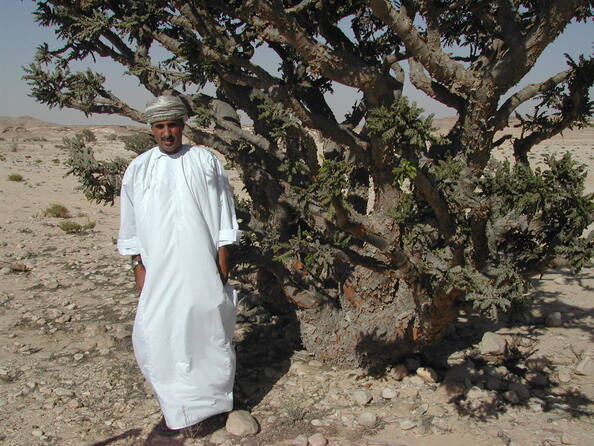遗产数据库
乳香之路
瓦迪•道卡的乳香树和什斯尔/乌芭尔以及相关的科尔罗里和巴厘德港口的商队绿洲遗迹,都表明这里的乳香贸易繁荣了很多世纪。这项贸易在古代和中世纪是最重要的商业活动之一。
乳香之路位于阿曼佐法尔省境内,是古代以及中世纪时期最重要的商业活动区之一。2000年作为世界文化遗产被列入《世界遗产名录》。
遗址简介
乳香之路,又称乳香贸易遗址,是阿曼古代和中世纪乳香贸易的场所,这个场所主要种植乳香树,并保留有历史上进行乳香贸易的绿洲遗迹。乳香树和商队绿洲遗迹可以证明,此处的乳香贸易在多个世纪内一直繁荣,因而这一地区在当时也是至关重要的。
乳香在古代是一种极昂贵、极奢侈的香料。乳香是一种飘着淡雅清香的树脂,过去常常被用作熏香和医疗道具,受到古埃及、古罗马及其他国家人民的高度赞美。阿曼是乳香、芳香树胶的古老产地,这些产品一度被认为比黄金更为珍贵。
在阿曼发现的考古遗址群中可以发现当时乳香香料生产和贸易的繁荣兴盛。瓦迪•道卡的乳香树、希什尔的商队绿洲以及霍罗尔和阿尔巴利迪的港口向人们生动地再现了乳香贸易活动的存在,它们都是中世纪时代波斯湾最典型、最著名的有防御工事的居民聚居地。
2000年,阿曼乳香之路的四个遗址于2000年被列入世界文化遗产目录。它们是盛产乳香的杜克河谷,它距离阿曼著名城市萨拉拉约40公里;出口乳香的霍尔罗港口;保留古代往来沙漠商队足迹的绿洲叙氏尔,它位于鲁卜哈利沙漠的南端,距离萨拉拉城170公里;位于佐法尔省的巴利迪城。
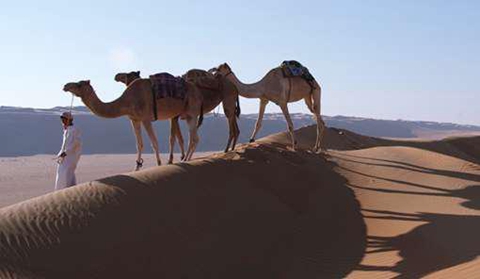
历史探寻
在阿拉伯,至少在公元前2000年就使用了乳香,直到公元400年罗马大帝君士坦丁下令禁止使用火葬之后,乳香市场才逐渐消失。
一位考古学家沿着古代的商业路线前行,寻找这个鲜为人知的乳香文化和没药树留下的任何蛛丝马迹,纺锤形的树林飘荡着一股芬芳而清香的树脂味。在古代,从罗马到印度,这些飘香的树脂一度受到人们的高度青睐,从宗教到化妆品,甚至在医疗方面,它们都具有极为重要的价值。根据基督信仰的传说,东方三博士想寻访基督幼年的画像,于是他们带着三件礼物,来到耶稣诞生地伯利恒,其中有一件礼物就是乳香,另外两件是金子和没药树,这也显示了乳香在古代人心目中所具有的重要性。
几百年以前,骆驼商队驼着乳香,穿过阿拉伯半岛的最南端,将其运往罗马、波斯(现在的伊朗)和远东地区。在这繁杂的商业性网络工程中,由于有驯养的骆驼,使运输工作能够得以顺利进行。将这些珍贵的树脂从它们所生长的偏僻的小山谷中运到目的地市场,以飨皇帝和国王之用。规模浩浩荡荡的商队迂回前行,运行这些被称为乳香的树脂,它们散发着芬芳的香味,极为珍贵。这种商业运输活动一直延续,长达2400年之久。这些古代的商业路线的沿线,有许多拥有城防工事的要塞城市,但是由于受到来自阿曼和也门地区无穷无尽的砂子的侵袭,都已经被沙漠掩埋,消失殆尽了,只有凭借拥有先进技术的航天飞机的帮助才能找到这些古代踪迹。
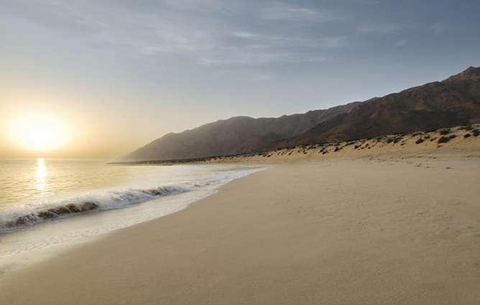
乳香之路有两条路线,海上航线和陆路商道。陆路通道起点是阿拉伯半岛的南部地区临近阿拉伯海的沿岸港口基纳,当时隶属于古也门国土;终点是地中海岸边巴勒斯坦的加沙。途中经过也门的舍卜洼省、马里卜省、焦夫省,到达纳季兰后,商道分成了两路。一路向北进发,到达沙特阿拉伯的北部佩特拉后,转至到美索不达米亚,即两河流域。另外一路从纳季兰出发,转道到达大马士革和其他腓尼基沿岸的各个城市。海上航线从阿拉伯半岛南端出发,沿红海北上,一直到埃及和其他地区,此航线完全由阿拉伯商人独占。
无论走海路还是走陆路,乳香商道必须经过也门的“马因王国”和“赛巴王国”统治的领地。“马因王国”是也门历史上出现的第一个国家,首都盖尔诺,建在今天也门的焦夫地区。马因人曾占领了南起哈达拉毛省,北至希贾兹的阿拉伯半岛的大部分区域,其势力一度扩展到巴勒斯坦南部和埃及东北部。马因王国在哈达拉毛王国和盖特班王国支援下控制着经阿拉伯半岛到埃及、叙利亚的商路,武装护送骆驼商队,从中获得巨大的收益。约于公元前630年,马因王国被萨巴人征服。“赛巴王国”的兴起是也门历史上最辉煌的一页,是也门人引以自豪和骄傲的一段历史。“赛巴王国”的首都在今天的也门马里卜省。日益强大的萨巴王国,全力发展与两河流域的贸易往来,以保证半岛商道的正常运行。萨巴女王毕勒基斯出访耶路撒冷,送给所罗门王大量的香料、宝石、金子。女王访问的目的之一,获得保证通往埃及和地中海东岸的商路安全的承诺。
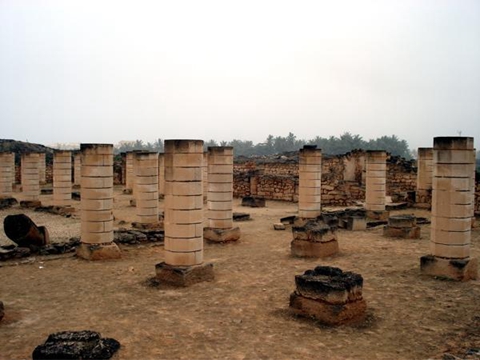
乳香之路在也门地区的衰败有两个原因。第一个是气候。公元6世纪阿拉伯半岛出现大规模的沙漠化现象,鲁卜哈利沙漠中的绿洲逐渐消失,变成无人地带,骆驼商队无法通过,再加上途中经常遭遇土匪抢劫,陆路交通越来越困难。第二原因是罗马帝国和波斯人的兴起。公元40---50年间,罗马人探得了阿拉伯海、印度洋季风的秘密,打破也门人独霸红海贸易通道的格局,也门的海上贸易走向衰落。史书记载,也门变成波斯的一个行省后,波斯人把商道从阿拉伯半岛西部转移到波斯湾和两河流域,使也门又失去了陆路国际贸易的利益。西方不通,东方通。公元11世纪,阿曼开辟至中国广州、泉州的海上航线,每年直接向中国出口大量的乳香和没药。也门完全失去了控制国际贸易商道的地位。
时光隧道中穿梭几千年,乳香回归自然,梦幻变成现实,乳香的价格不再等同黄金。乳香从王侯贵族的神庙、宫殿里重新回到百姓手中。走进也门的小巷,踏上光滑滑的石板路,从陈旧狭窄的木窗里,时而飘出淡淡的乳香气味。
走进萨那古城,一家接一家的小店密密麻麻,有的店窄小得只有一个人坐着的位置,店主萎缩里面,周围所有的商品都可以伸手拿,这样的不起眼的店铺也可能有长达几百年的历史,蜗居在古城里占据一席之地。你会听见主人讲述他的家族上千年前的辉煌。在美国上百年的文物被认为是奇货可居,在也门的老城你闭着眼睛随便一指,任何一栋石头楼的历史都会让美国人汗颜无地。乳香放在草编筐里混杂在胡椒、大蒜、桂皮、姜之类的调料间,等待顾客的来临。节假日临近之际,在高大雄伟的“也门之门”附近的大街人行道边,你会看见犹如乞丐般的老人,白发苍苍,地上铺张报纸或布,摆放着小块、不规则大小、粗糙的白色或黄色微红的乳香叫卖,地上有个旧小铝碗,作为盛器。你买多少钱的,拿碗盛给你,一天也卖不出多少钱,小堆乳香的上端是如指甲般的大块,下面是被人挑剩下的捻碎的粉未状的乳香。大部分行人对此不屑一顾,匆忙走过。行人买乳香主要用于咀嚼,清新口齿。
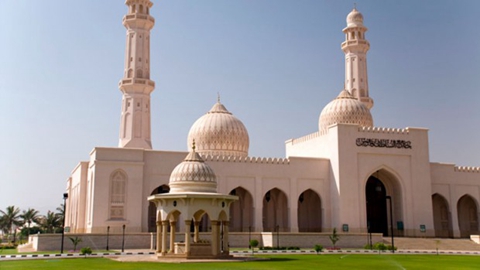
考古挖掘
2000年来,研究人员发现了一座已经消失的槽钢城,它就是圣经、各种伊斯兰文章及阿拉伯民间故事中所提到的乳香贸易中心。据推测,槽钢城是以极其恶劣的方式被埋葬的。在卫星和雷达图像的帮助下,人们发现了这座古代城池。他们还认为,沿着这条重要的商业路线,一定还会有其它的城堡散布在这里。根据古罗马历史学家普利尼的推断,沿着这条乳香商业路线,共有8座城市,而且这些城市周围很有可能有水源。
塞拉莱是沿阿拉伯海岸线走行、位于马斯喀特南部的一座城市,以丰富的文化和美丽的风光而闻名。今日的塞拉莱对阿曼的经济繁荣发展起者重要的作用。塞拉莱有现代化的港口、大学、医院,酒店业也很发达。塞拉莱尽管地处热带沙漠地区,但气候与地形与阿曼其它城市有很大的不同。
由于受到季风吹拂和间断下雨的缘故,这里泉水处处、绿意盎然,生产的作物有椰子、木瓜、芭蕉等,并且到处可见棕榈树和肥沃的农田。塞拉莱是一座古城,与古代乳香之路有着密切的关系,现在乳香之路的一些城市已经被岁月所埋没,仅有塞拉莱还保存着。
Land of Frankincense (Oman) © UNESCO
Land of Frankincense
The frankincense trees of Wadi Dawkah and the remains of the caravan oasis of Shisr/Wubar and the affiliated ports of Khor Rori and Al-Baleed vividly illustrate the trade in frankincense that flourished in this region for many centuries, as one of the most important trading activities of the ancient and medieval world.
Outstanding Universal Value
Brief synthesis
The four components of the Land of Frankincense dramatically illustrate the trade in frankincense that flourished in this region for many centuries. They constitute outstanding testimony to the civilizations in south Arabia since the Neolithic.
The successive ports of Khor Rori (4th century BC to the 5th century AD) and Al Baleed (8th century till 16th century AD) and an outpost close to the Great Desert Rub Al Khali, Shisr, about 170 km inland, represent in a unique way the distribution of frankincense which was produced in the wadis of the coastal hinterland. All three sites were exceptionally fortified. Wadi Dawka is an outstanding example of the growth of the frankincense tree (boswellia sacra) from which the resin was produced, collected and traded.
The port of Khor Rori (the Moscha Limen of classical geographical texts) lies 40 km to the east of Salalah on a hilltop on the eastern bank of a sweet-water outlet (khor). About 400 metres from the open sea, it dominates the khor which opens to the sea and served as a natural harbour. The remains of the fortress are located on a rocky spur running east-west, forming part of a wider defensive system, details of which are still evident. The walls have dressed stone faces with rubble cores. The most heavily fortified part is on the north, where the entrance is located, itself a massive structure with three successive gates on the steep entry path. It is flanked by the remains of towers. The port was refounded at the end of the 1st century by LL'ad Yalutas (evidenced by an inscription still in situ) to control the trade in Dhofar incense. It was the hub of the trading settlements on this coast at that time. The process of disintegration began in the 5th century.
Al-Baleed, a harbor directly placed on the beaches of the Indian Ocean with a khor, a sweet water reservoir behind it, is the historically late name for the town. Artifacts from China (Ming) and other countries indicate its importance as a harbor along the ′Silk Road to the Sea′ from where, in exchange, frankincense was also traded. Though heavily fortified, the town was attacked and partially destroyed on several occasions in the 13th century. By the late 15th century, radical changes to trading patterns imposed by Portuguese and other European trading nations sealed the fate of the town.
Shisr lies about 180 km north of Salalah in the desert. This agricultural oasis and caravan site was a very important station also for water supply on the routes from the Nejd and the hinterland from where frankincense was brought to the ports along the coast.
Wadi Dawkah is a major place where the frankincense tree (boswellia sacra) can still be found and frankincense is harvested to this day. The wadi seasonally drains the north-south mountains disappearing into the desert of the ′Empty Quarter′, the Rub al Khali. The trees grow in the alluvial bed of the wadi under the extreme heat of this region.
Criterion (iii) : The group of archaeological sites in Oman represent the production and distribution of frankincense, one of the most important luxury items of trade in the Old World in Antiquity.
Criterion (iv) : The Oasis of Shisr and the entrepots of Khor Rori and Al-Baleed are outstanding examples of medieval fortified settlements in the Persian Gulf region.
Integrity
The Land of Frankincense sites include all elements necessary to express its Outstanding Universal Value. The property is of adequate size to ensure the complete representation of the features and processes underpinning the property’s significance. All attributes of Outstanding Universal Value are fully present within the properties. All are fully present, none are eroded and the dynamic functions between them are fully maintained.
The property does not suffer from adverse effects of development and/or neglect. Due to the full protection of the sites no threats can be observed. Through protection of all four sites by the government of all sites the integrity is guaranteed. All buffer zones have been respected and no encroachment can be observed. All properties are fenced and the buffer zones marked.
Authenticity
The authenticity of the property is not open to question. Three components are archaeological sites that have had no inhabitants for centuries and the fourth is a natural site in a desert area.
Protection and management requirements
The property is protected by the Royal Decree No. 6/80 on the protection of the national heritage, and its buffer zone was given legal status by Royal Decree No. 16/ 2001. The property is managed through a Management Plan. The sites are fenced and the buffer zones are marked. In Shisr, a small settlement of the Bedouins lies within the buffer zone (radius of 700 meters from the property center). Also in Shisr the palm trees of the oasis, part of the buffer zone, will be replaced by young trees by the authority. The re-generation and maintenance of plantation schemes will be essential in the future.
Major measures have been undertaken to maintain the property’s authenticity and integrity and to protect the archaeological sites against interventions by visitors. Visitors must use only the access paths which are laid on Geo-textiles to protect the archaeological surfaces. In the ruins the stone walls of buildings have been protected with sacrificial layers of stone.
All the archaeological parks are in very good condition, and Al Baleed and Khor Rori have Visitor Interpretation Centres to manage the number of visitors (in 2014 more than 150000) and introduce them to the cultural background of the sites. An Interpretation Centre for Shisr is being planned. The Land of Frankincense sites are an integral part of a long-term sensitive cultural tourism strategy to inform regional, interregional and international visitors about the rich tradition of the Land of Frankincense.

